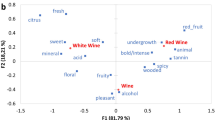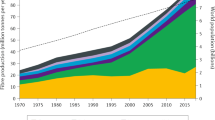Abstract
Wine production is both art and science, a blend of individual creativity and innovative technology. But wine production is also business, with economic factors driving manufacturing practices. To be successful in the modern marketplace, a winemaker must integrate the artistic and economic aspects of wine production, and possess a solid understanding of the intrinsic and extrinsic factors that underlie purchase motivation.
This is a preview of subscription content, access via your institution
Access options
Subscribe to this journal
Receive 51 print issues and online access
$199.00 per year
only $3.90 per issue
Buy this article
- Purchase on SpringerLink
- Instant access to full article PDF
Prices may be subject to local taxes which are calculated during checkout



Similar content being viewed by others
References
Lucia, S. P. A History of Wine as Therapy (Lippincott, Philadelphia, 1963).
Laville, P. Le terroir, un concept indispensable a l'elaboration et á la protection des appellations d'origine comme a la gestation des vignobles: le cas de la France. Bull. OIV 217, 709–710 (1990).
Protin, R. Situation de la viticulture dans le monde en 1970. Bull. OIV 44, 110–1057 (1971).
Anonymous. The state of viticulture in the world and the statistical information for 1999. Bull. OIV (Suppl.) 20–30 (2000).
Aigrain, P. Conjuncture vitiviniculture mondaile. Bull. OIV 74, 209–225 (2001).
Renaud, S. & De Lorgeril, M. Wine, alcohol, platelets and the French paradox for coronary heart disease. Lancet 339, 1523–1526 (1992).
Marmot, M. G., Rose, G., Shipley, M. J. & Thomas, B. J. Alcohol and mortality: A U-shaped curve. Lancet I, 580–583 (1981).
Kinsella, J. E., Frankel, E. N., German, J. B. & Kanner, J. Possible mechanisms for the protective role of antioxidants in wine and plant foods. Food Tech. 47, 85–89 (1993).
Steinberg, D. Modified forms of low-density lipoprotein and atherosclerosis. J. Int. Med. 233, 227–232 (1993).
German, B. G., Frankel, E. N., Waterhouse, A. L., Hansen, R. J. & Walzen, R. L. in Wine: Nutritional and Therapeutic Benefits (ed. Watkins, T. R.) 196–214 (Am. Chem. Soc., Washington DC, 1997).
Gronbaek, M. et al. Type of alcohol consumed and mortality from all causes, coronary heart disease, and cancer. Ann. Int. Med. 133, 411–419 (2000).
Nijveldt, R. J. et al. Flavonoids: a review of probable mechanisms of action and potential applications. Am. J. Clin. Nutr. 74, 418–425 (2001).
De Lorimier, A. A. Alcohol, wine, and health. Am. J. Surg. 180, 357–361 (2000). [Also available at 〈http://www.medicalfriendsofwine.org/alchowine.htm〉 (2001).]
Stevenson, R. L. The Amateur Emigrant and The Silverado Squatters (Scribner's Sons, New York, 1923).
Yegge, J. & Noble, A. C. in Proc. ASEV 50th Anniv. Annu. Meet. (American Society for Enology and Viticulture, Davis, 2000).
Firestein, S. How the olfactory system makes sense of scents. Nature 413, 211–218 (2001).
Rouquier, S., Blancher, A. & Giorgi, D. The olfactory receptor gene repertoire in primates and mouse: evidence for reduction of the functional fraction in primates. Proc. Natl Acad. Sci. USA 97, 2870–2874 (2000).
Sosinsky, A., Glusman, G. & Lancet, D. The genomic structure of human olfactory genes. Genomics 70, 49–61 (2000).
Brand, G., Millot, J.-L. & Henquell, D. Complexity of olfactory lateralization processes revealed by functional imaging: a review. Neurosci. Biobehav. Rev. 25, 159–166 (2001).
Ishibashi, T., Harada, S., Fugii, C., Taguchi, A. & Ishii, T. Relationship between ALDH2 genotypes and choice of alcoholic beverages. Jpn. J. Alc. Stud, Drug Dep. 34, 117–129 (1999).
Ebeler, S. E. in Flavor Chemistry: 30 Years of Progress (eds Teranishi, R., Wick, E. L. & Horstein, I) 409–421 (Kluwer Academic/Plenum, New York, 1999).
Acree, T. E. GC/Olfactometry: GC with a sense of smell. Anal. Chem. 69, 170A–175A (1997).
Guth, H. Identification of character impact odorants of different wine varieties. J. Agric. Food Chem. 45, 3022–3026 (1997).
Guth, H. Quantitation and sensory studies of character impact odorants of different white wine varieties. J. Agric. Food Chem. 45, 3027–3032 (1997).
Guth, H. in Chemistry of Wine Flavor (eds Waterhouse, A. L. & Ebeler, S. E.) 39–52 (Am. Chem. Soc., Washington DC, 1998).
Voilley, A. & Lubbers, S. in Chemistry of Wine Flavor (eds Waterhouse, A. L. & Ebeler, S. E.) 217–229 (Am. Chem. Soc., Washington, DC, 1998).
Dufour, C. & Bayonove, C. L. Interactions between wine polyphenols and aroma substances. An insight at the molecular level. J. Agric. Food Chem. 4, 678–684 (1999).
Jung, D.-M., De Ropp, J. S. & Ebeler, S. E. Study of interactions between food phenolics and aromatic flavors using one and two dimension 1H NMR spectroscopy. J. Agric. Food Chem. 48, 407–412 (2000).
Noble, A. C., Flath, R. A. & Forrey, R. Wine headspace analysis. Reproducibility and application to varietal classification. J. Agric. Food Chem. 28, 346–353 (1980).
Ohmart, C. P. & Matthiasson, S. K. Lodi Winegrower's Workbook: A Self-Assessment of Integrated Farming Practice 〈http://www.lodiwine.com/winegrowersworkbook1.shtml〉 (2000).
Granett, J., Walker, M. A., Kocsis, L. & Omer, A. D. Biology and management of grape phylloxera. Annu. Rev. Entomol. 46, 387–412 (2001).
Hopkins D. L. Xylella fastidiosa: a xylem-limited bacterial pathogen of plants. Annu. Rev. Phytopathol. 27, 271–290 (1989).
Purcell, A. H. & Saunders, S. R. Fate of Pierce's disease strains of Xylella fastidiosa in common riparian plants in California. Plant Dis. 83, 825–830 (1999).
Lodhi, M. A., Daly, M. J., Ye, G.-N., Weeden, N. F. & Reisch, B. I. A molecular marker based linkage map of Vitis. Genome 38, 786–794 (1995).
Paquet, J., Bouquet, A., This, P. & Adam-Blondon, A.-F. Establishment of a local map of AFLP markers around the powdery mildew resistance gene Run1 in grapevine and assessment of their usefulness for marker assisted selection. Theor. Appl. Genet. 103, 1201–1210. (2001).
Donald, T. M. et al. Identification of resistance gene analogs linked to a powdery mildew resistance locus in grapevine. Theor. Appl. Genet. 104, 610–618 (2002).
Author information
Authors and Affiliations
Rights and permissions
About this article
Cite this article
Bisson, L., Waterhouse, A., Ebeler, S. et al. The present and future of the international wine industry. Nature 418, 696–699 (2002). https://doi.org/10.1038/nature01018
Issue Date:
DOI: https://doi.org/10.1038/nature01018
This article is cited by
-
The complementary uses of Sentinel-1A SAR and ECOSTRESS datasets to identify vineyard growth and conditions: a case study in Sonoma County, California
Irrigation Science (2022)
-
Candidate resistance genes selection and transcriptome analysis for the early responses to Plasmopara viticola infection in grape cultivars
Journal of Plant Pathology (2020)
-
Genomic ancestry estimation quantifies use of wild species in grape breeding
BMC Genomics (2016)
-
Exploring adaptation choices for grapevine regions in Spain
Regional Environmental Change (2016)



